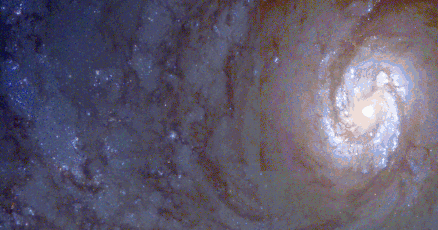
|
Explanation: The distance to the swirling grand design spiral M100 is causing quite a stir among astronomers. Many believe that the Hubble Space Telescope's recent distance measurement to this galaxy accurately calibrates the expansion rate of the universe. Others believe this distance measurement is misleading. The universe's expansion rate is usually given as a quantity called "Hubble's constant", a factor dividing well-measured recession velocity of a galaxy to give actual distance. Scientific debate over the value of Hubble's constant has been ongoing since it was first measured by Edwin Hubble in 1929. A real live debate involving the value of Hubble's constant titled "The Scale of the Universe" will occur in April 1996 in Washington, DC.
|
January February March April May June July August September October November December |
| ||||||||||||||||||||||||||||||||||||||||||||||||
NASA Web Site Statements, Warnings, and Disclaimers
NASA Official: Jay Norris. Specific rights apply.
A service of: LHEA at NASA / GSFC
& Michigan Tech. U.
Based on Astronomy Picture
Of the Day
Publications with keywords: universe - M 100
Publications with words: universe - M 100
See also:
- APOD: 2024 December 1 Á Cosmic Latte: The Average Color of the Universe
- APOD: 2024 October 20 Á Dark Matter in a Simulated Universe
- APOD: 2024 July 1 Á Time Spiral
- M100: A Grand Design Spiral Galaxy
- APOD: 2023 December 31 Á Illustris: A Simulation of the Universe
- APOD: 2023 July 5 Á A Map of the Observable Universe
- APOD: 2023 June 29 Á A Message from the Gravitational Universe
